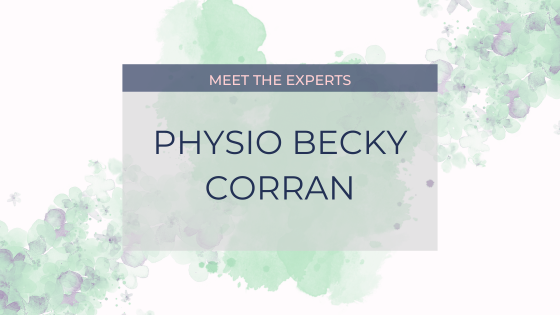Many people believe that pregnancy can spell disaster for your pelvic health. Gillian McCabe, Women's Health Physiotherapist explains why this doesn't have to be the case.
How did you end up working in Women's Health?
I actually went into women’s health a little unwillingly to be honest! I had completed what was called my ‘junior rotations’ in the NHS and was asked to put together a priority list of where I wanted to rotate to as a senior physiotherapist. I put my list together with women’s health firmly at the end! A few days later, I received a phonecall telling me that it was great news, I had secured a position as a senior physiotherapist (now known as band 6) and I would be starting the following week. “Great” I thought. With visions of starting my dream rotation in an outpatient musculoskeletal physiotherapy department, I started to celebrate. Until I heard the dreaded words, “so you will meet with your line manager in women’s health on Monday”.
Those emotions of dread seem so far away from how I feel today. I spent 6 months on rotation in women’s health with a fantastic team and clinical specialist. I loved every minute of my time there, so when my male colleague called to ask if I would swap rotations with him and remain in women’s health, I didn’t hesitate. I worked as a women’s health physiotherapist for 18 months before I rotated to another post. Within a month, I heard that a permanent position was available in the women’s health team and jumped at the opportunity.
Eleven years later, and I’m here working as a specialist physiotherapist in women’s health and loving every minute! I am running my own clinic in the private sector, and although I miss my colleagues in the NHS, I’m really enjoying this new challenge! I have a huge number of plans for 2018, as I’m sure lots of us have. So I’m excited to work out the plans over the next 12 months and grow my business to help more and more women dealing with pelvic health related issues.
Let's get down to the basics: What is the pelvic floor?
Lots of women know about their pelvic floor but it is so important to really get to know your ‘down below bits’. Our pelvic floor is a group of muscles that are literally the floor to our pelvis. If you are sitting down reading this blog, you’ll be sitting on your pelvic floor. But it’s not your buttocks, it’s the area between your seat bones and the area between your pubic bone and tailbone. This is a sort of diamond shape if you simplify it.
The pelvic floor is attached to the ligaments and fascia (connective tissue) that runs through the pelvis.
It’s like a hammock or a trampoline.
The ligaments and fascia are the side rims or supports and the pelvic floor is the central material of the hammock.
The muscles are contractible, that is, you can squeeze them to shorten them and you can release them to lengthen them, just like any other skeletal muscle in your body.
Due to their position, they actively support the pelvic organs. These are the bladder, womb and bowel. If the muscles are not functioning correctly, problems can occur such as leakage from the bladder or bowel, movement of the organs and even pain. Although it’s small area, it’s pretty complex and well designed to do a number of jobs all at the same time. Sometimes it’s weakness and sometimes it’s over activity that causes these problems. But overall, the muscle needs to function, it needs to squeeze when pressures in the tummy and pelvis increase and it needs to let go at other times. It’s not all about keeping it tight! If you only tightened your bicep and never let it go, you would never be able to reach out for that chocolate bar!
What happens to the pelvic floor during pregnancy and birth?
First of all, let’s not panic about childbirth and the effects on the pelvic floor, it’s designed really well to stretch and allow for birth. It really stretches a great deal, but it can also recover really well too. However, in some cases there can be some trauma such as a tear or an episiotomy (cut), also there can be bruising, swelling and tenderness or even pain. All of these things can lead to a switching off of the muscles. So it’s important to prepare the pelvic floor in pregnancy with a good training programme and rehabilitate it after any type of childbirth (and that goes for c-sections too). I provide the Mummy MOT programme and find that all of my post natal clients need pelvic floor muscle training. I would advise seeing a local pelvic health physiotherapist to get assessed, mainly because 30% of women that receive verbal education are still unable to produce a good quality pelvic floor muscle contraction. Thorough assessment and education with a specialist is ESSENTIAL!
Will we ever be able to jump on a trampoline without leaking again?
Well, funny you should ask that. I recently saw a lady who was 6 months post natal. I asked her what her goals were and she came up with the common ones of getting my body back, losing some weight, keeping active and maybe trying to get in to running. So I pushed her a little further and asked if there was anything she really wanted to be able to do. Her answer, after a long pause was that she absolutely LOVED trampolining, she found it so enjoyable and therapeutic, but she knew she’d never do that again. 3 months into her Mummy MOT programme and she has booked a regular slot at a local trampolining centre. She’s learning all the techniques and making new friends. No leakage, no prolapse, no problem!
It is possible, with the right assessment, the right training and the right level of commitment, I would never say never!
Can we do anything to prepare before we have our babies?
It is really important to get to know your pelvic floor and to become more body aware before childbirth and even before pregnancy. If you know how to perform a really good pelvic floor exercise before the event of childbirth, you’re more likely to be able to complete something similar afterwards. So many of my post natal clients hadn’t given one thought to their pelvic floor before the birth, and it’s quite a challenge to train a weak or traumatized muscle if it’s the first time the owner has ever thought about it.
I could lay out a pelvic floor training programme for pregnancy, but that would seem ridiculous to me. Everyone has a different level of ability and I don’t want to make anyone work too little or too much. This is why a pelvic health specialist is so important. Every woman should have one to call on at any time (well, during working hours anyway!). My advice is to find your pelvic floor, learn how to squeeze it, learn how to release it and then exercise it regularly including a combination of slow holds and fast squeezes.
Is it just about kegels and the pelvic floor?
Nope! The pelvis is the link from the upper body to the legs, the pelvic floor is the floor to the pelvis. When we move, when we lift, when we cough, when we exercise, we use a load of muscles, we use a load of fascia and connective tissue and we use our minds too! We have to have a holistic approach to every part of our body.
Let me give you an example:
I saw a lady at 6 weeks post natal for a Mummy MOT. She had delivered by forceps a baby boy weighing in at 9lbs 10ozs. She had an episiotomy that had healed well, no leakage, no prolapse, no pain. She wanted to get back into her old exercise routine of gym cardio and weights. During the assessment, I gave her a 4kg barbell to hold to see how she coped with lifting strategies. Her reply was a classic, I can’t possibly lift that, I’m only 6 weeks post natal and I had an episiotomy.
This is a common case of ‘I can’t’ due to the fears of ‘what if something goes?’ or ‘what if I lose control of my bladder’ or ‘my health professional said I shouldn’t’ or ‘I read somewhere I can’t’. It took a little convincing to restore her faith in her body, but when she realized that she was regularly lifting and carrying her baby, the car seat, the pram, the wet washing from the machine and the shopping full of tins and heavy objects, she realized that the little 4kg barbell was nothing to be afraid of at all!
Our minds can limit us physically, our belief systems and our knowledge. It’s our job as pelvic health professionals to inform, educate and guide these women to be strong, independent and courageous with their bodies. Women need to be fit and strong, their everyday lives are demanding. Our programmes, our advice and our guidance needs to acknowledge this. Women can do amazing things when children are involved, I see this every day with friends, family and clients. But there is so much fear and doubt that really isn’t necessary.
What is the most important thing you advise women straight after having their babies?
My advice? Get out there, challenge your bodies, live the life you want to live but get the right health professionals behind you!
Stay away from negative chatter online.
Surround yourself with the right education, the right information
Thing realistically about your every day activities.
As a mum, you are no longer sedentary, you are an athlete and you need to use your body well, nourish it, look after it and let it grow stronger!
What should we be doing after that initial postnatal period?
I usually advise a 6 week period of relaxation, bonding, TLC and nourishment after childbirth. Whatever birth you have experienced, use this 6 weeks to enjoy the baby, rest your body and get into good routines. Life as a mum is super busy, and it doesn’t let up, so don’t be quick to put pressure on your body or your mind. You can be active by going out for walks, getting fresh air and pottering around the house. You can learn to nourish yourself by drinking water regularly, make yourself (or even better, get someone else to make you) fresh smoothies full of good fruit and veg. Get sleep when you can (easy for some!) – but be disciplined about it. Avoid the caffeine and the sugar, it plays havoc with your healing and doesn’t help with the highs and lows through the day. And enjoy being with the baby and your partner, it’s a special time, it goes so quickly, so don’t spend it worrying about what you should be doing, where you should be going or how your body should be looking.
Is your advice different to mums who have had cesareans?
Nope, exactly the same. Use the first 6 weeks for healing. Listen to your body and only do what you can. It’s more difficult if you have other children. If you have the luxury of family and friends, use them in that time to help out rather than visit and drink tea (although, that’s nice too!)
Many of our ladies are worried about the gap down the middle of their tummy after having a baby - what can we do about this?
Use the 6 week care rule to begin with as mentioned above.
The majority of women will find that their tummy gap will heal well and restore to fairly normal by about 8 weeks post birth. In some cases, a core restore programme might be needed. It’s not all about the sit ups and planks and double straight leg raises. It’s about learning to use your abdominal muscles correctly. The Mummy MOT programme can really help with this as it gently guides you to correct muscle function and activity for every day life.
I often see women carrying their little ones on one hip, this can cause extra tension through one side of the abdominals and back. So it’s important to be mindful of how lifting can affect your tummy. As part of my programme, I always work on restoring balance from one side of the abs to the other and then teach the ladies to retrain their lifting and carrying technique to optimize their abdominal healing.
But it’s not all about the ‘gap’, to be honest, I’m not too worried about it. If you use your abs correctly, same as with your pelvic floor, the muscles will support and you will maintain control. So, if you are worried about being able to fit a couple of fingers between your abs, don’t panic and don’t avoid exercise, just book in with your local pelvic health physiotherapist and find out what you can do to rehabilitate the area.
What do you advise for ladies struggling with intimacy after having their baby?
This is a common problem and the first thing to note is that in the first few times, intimacy is often uncomfortable and not the same as before childbirth. There are obvious factors here, such as, scar tissue, muscle tension, reduced natural lubrication and muscle wastage. These are all manageable with pelvic floor physiotherapy. It’s worth buying some oil based, organic lubricant such as YES OB. But I would use it more regularly that just with intimacy. Pop a bit on your labia and vagina after every wee and use it regularly like this for a while. It’s a great way to improve lubrication, reduce friction and reduce any inflammation. If your scar has healed, it’s a good time to massage it a little, moving a scar gently, within tolerance levels of any sensitivity will help to make it more flexible. When intimacy does happen, the scar will be more flexible and less sore.
I would also advise learning how to breathe correctly. Often after pregnancy and childbirth, breathing can go a bit haywire and the diaphragm and pelvic floor can become a bit rigid and tight. Add to this the nervousness of pain with intimacy and you have a recipe for discomfort. It’s important to breathe into the diaphragm and feel the base of the rib cage move, allow your tummy to soften as you breathe, avoid sucking in the tummy all the time. This will help to release the abdomen and diaphragm and should have a knock on effect to the pelvic floor. You then want to encourage a release or an opening of the pelvic floor, not a bearing down or straining, just a release. It can take a bit of practice and if you’re struggling, I would get help from your local pelvic health physiotherapist. Sometimes, you may need to massage the area and learn through hands on teaching to let it go. My clients often tell me that my theme tune should be ‘Let it Go’ from the film Frozen. Perhaps it’s the case. I am ALWAYS teaching women to stop gripping on with their pelvic floor and it has a massive impact on pain, discomfort and their sex life.
What is the biggest concern new mums come to you with?
It varies a lot really. We are all individuals and our goals will be different. I possibly see running as a regular goal. Some women want to run a marathon within a year of giving birth and see maternity leave as a great time to train. Others want to get their bodies back to pre-pregnancy. Others are concerned about their abdominals. But I think the majority ask to be able to run around after their children, they simply want to live the family life they have planned.
All my assessments and treatment programmes are bespoke. I sit down with my clients and ask them what they want to achieve. I relate that to my assessment findings and together we come up with a master plan.
Should everyone try and see a Womens Health Physio after having a baby?
Yes, DEFINITELY! In my opinion, every woman should have a women’s health or pelvic health physiotherapist. I might live in cloud cuckoo land, but I really think that a lot of problems, both physically and mentally can be avoided through proper specialist care. And not just with physio either, a full multi-disciplinary approach is needed. I have set up a group of professionals in Cardiff who all work in the field of pelvic health. We all work together for the benefit of the patient. We have a consultant obstetrician, urogynaecologist and colorectal specialist, pain specialist, bowel health nurses, physiotherapists, nutritionists, dietitians, fitness professionals, podiatrists, psychotherapists, acupuncture specialists, hypnobirthing specialists and more. It’s so important to wrap the client in a blanket of support from well educated and caring professionals who ultimately make them confident to go out and live their lives without fear and doubt.
Thank you so much Gillian! I know the time you have spent answering our myriad of questions will really help women understand how to look after themselves throughout their pregnancies and beyond.
Gillian can be found at her private practice gillianmccabe.co.uk. For more advise and support you can follow Gillian on Twitter @GillianMcPhysio; Facebook @gillianmccabephysio and Instagram @gillianmccabe.





